American heavyweights: From dominant to afterthought
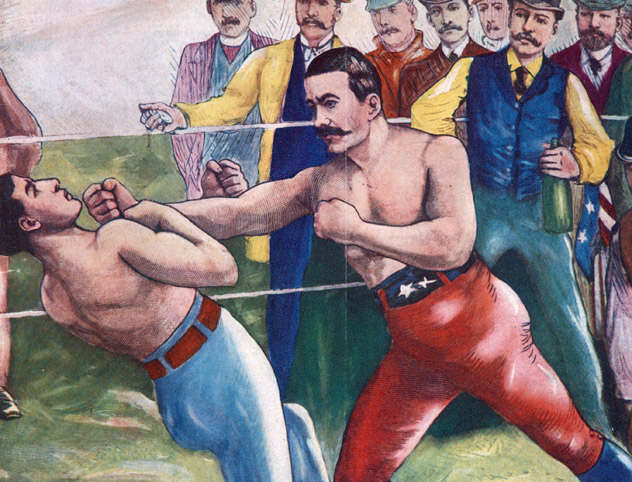
As we head into Saturday’s matchup between Bermane Stiverne and Deontay Wilder, The United States’ yearning for a heavyweight champion has surfaced once again. As Wilder, an undefeated knockout artist from Alabama, takes on incumbent WBC titleholder Stiverne, who indentifies as both Haitian and Canadian, he’ll be attempting to buck a considerable trend. This story originally appeared in the August 2014 issue of THE RING Magazine.
The state of American heavyweights might be at its lowest point since bare-knuckle boxing was transitioning into the gloved era in the 1870s. Gone are the days when larger-than-life legends such as John L. Sullivan, Joe Louis and Muhammad Ali led the way as Americans dominated the sport’s glamour division. The shift took place in the 1990s, as the decline of boxing’s popularity drove athletic American men who weighed more than 200 pounds toward easier sports like football and basketball.
For the vast majority of the past 120 years, the world heavyweight championship was in American hands. There were plenty of contenders from Europe who made it into the Top 10 through the decades, but only Max Schmeling and Ingemar Johansson legitimately interrupted the U.S. dominance. Then came Lennox Lewis and nothing was the same for Americans thereafter. A handful of Yanks have won big heavyweight fights and titles over the past 20 years but they were the exception rather than the rule.
In this feature THE RING ranks the 10 best American heavyweights by decade, with those who held a major title in bold text. You can see by the names and bold lettering that the Americans’ fortunes had changed in the 2000s. They still won some titles but most reigns were very short.
A few more things to keep in mind:
-
You’ll notice that fewer names are in bold in the early centuries. That’s the case primarily because there was only one recognized heavyweight champ until the 1960s, when myriad sanctioning bodies popped up.
-
If given the option of listing one boxer for two decades or allowing entry to a fighter whose achievements were nominally inferior in terms of overall accomplishment, I chose the latter.
-
Head-to-head losses could be overcome (the “styles makes fights rule”) if one boxer’s work in that decade was overwhelming in length of dominance and quantity.
-
It was more difficult to rank boxers before the 1950s because many light heavyweights and even middleweights scored significant victories in the heavyweight division.
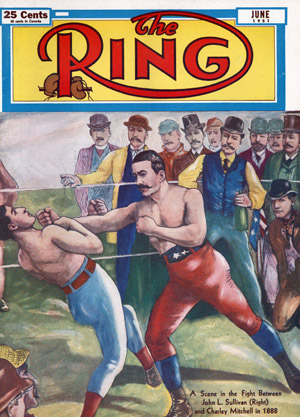 1880s
1880s
1. John L. Sullivan
2. James J. Corbett
3. Jake Kilrain
4. Pat Killen
5. Mike Conley
6. Joe McAuliffe
7. Billy Wilson
8. Charles Hadley
9. Jack Ashton
10. Jack Fallon
Non-American titleholders: None
The first American-bred boxing superstar, John L. Sullivan, emerged in this decade even though the sport was in its infancy in the U.S. Sullivan dominated opponents in the ring – “My name is John L. Sullivan and I can lick any sonofabitch in the house” – and then made a living on the vaudeville circuit. His larger-than-life persona set the trend for American heavyweights, who for many years were the biggest heroes and personalities in sports.
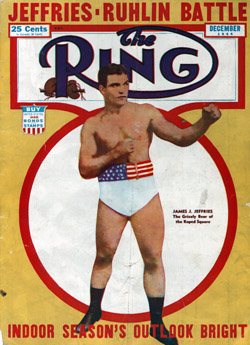 1890s
1890s
1. James J. Jeffries
2. James J. Corbett
3. Tom Sharkey
4. Joe Choynski
5. Charles “Kid” McCoy
6. Frank Childs
7. Gus Ruhlin
8. Bob Armstrong
9. Joe Butler
10. Ed Dunkhurst
Non-American titleholder: Bob Fitzsimmons (U.K.-New Zealand)
Boxing was still outlawed in many parts of the country during the 1890s but, as a result of rules changes and improved infrastructure, it was evolving into an accepted sport during the reign of popular champion Jim Jeffries. It was also the decade when boxing truly became national, as James Corbett ventured from the West Coast (San Francisco) to beat mainstays in the dominant Eastern corridors of power like New York City and Chicago.
 1900s
1900s
1. Jack Johnson
2. James J. Jeffries
3. Philadelphia Jack O’Brien
4. Joe Jeannette
5. Marvin Hart
6. Sam McVea
7. Fireman Jim Flynn
8. Gus Ruhlin
9. Al Kaufman
10. Mike Schreck
Non-American titleholder: Tommy Burns (Canada)
The talented and controversial Jack Johnson was forced to travel the world to get his deserved shot at the title, a blessing in disguise since “The Galveston Giant” would probably not have been allowed to compete for the heavyweight title on American soil, due to racism. When Johnson ripped the title from the diminutive Tommy Burns in Australia, it set off the infamous “White Hope” era.
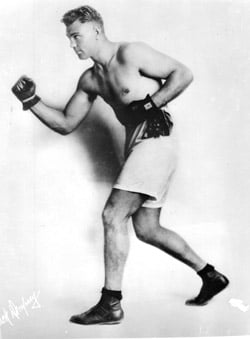 1910s
1910s
1. Jack Dempsey
2. Harry Wills
3. Joe Jeannette
4. Fred Fulton
5. Sam McVea
6. Gunboat Smith
7. Jess Willard
8. Jack Johnson
9. Kid Norfolk
10. Luther McCarty
Non-American titleholders: None
African-American heavyweights might’ve dominated the decade if not for the shameful “color line,” the result of Johnson’s controversial reign. Gifted boxers like Harry Wills and Joe Jeannette were denied the opportunity to fight for the world title, even by Johnson, who stood to make more money fighting white opponents. “Jack forgot about his old friends after he became champion and drew the color line against his own people,” Jeannette said.
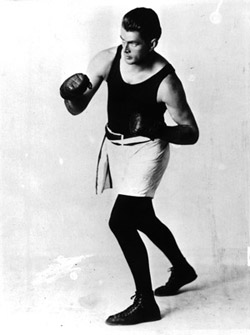 1920s
1920s
1. Gene Tunney
2. Jack Dempsey
3. Harry Wills
4. Jack Sharkey
5. George Godfrey
6. Tommy Gibbons
7. Young Stribling
8. Tommy Loughran
9. Tuffy Griffiths
10. Jim Maloney
Non-American titleholders: None
Standing atop the division were the odd couple of Dempsey and Tunney, their personality types and boxing styles polar opposites. The erudite and refined Tunney held sway in the ring, but over time Dempsey’s legend has managed to push Tunney aside in historical terms. It is probably better this way. Dempsey’s rags-to-riches and rough-around-the-edges manner is a better representation of the “Roaring Twenties.”
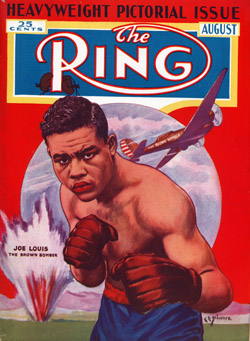 1930s
1930s
1. Joe Louis
2. Max Baer
3. Steve Hamas
4. Tommy Loughran
5. King Levinsky
6. Ernie Schaff
7. Johnny Risko
8. Maxie Rosenbloom
9. Lou Nova
10. Bob Pastor
Non-American titleholders: Max Schmeling and Primo Carnera
This was the peak of the sport’s popularity in number of boxers (in relation to other sports), boxing venues and available dates. Fans could attend fight cards nearly seven days a week in major cities like New York, Chicago, San Francisco, Los Angeles and Philadelphia. Boxing rivaled baseball and horse racing in popularity. And globally no sportsman was more famous than the heavyweight champion. Significantly, Joe Louis became a national hero despite the racial divide in America.
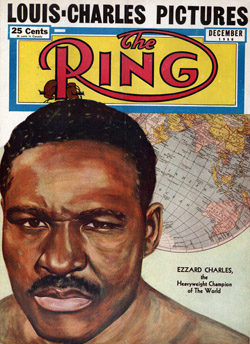 1940s
1940s
1. Joe Louis
2. Ezzard Charles
3. Jimmy Bivins
4. Jersey Joe Walcott
5. Elmer Ray
6. Archie Moore
7. Joey Maxim
8. Billy Conn
9. Gus Lesnevich
10. Tami Mauriello
Non-American titleholders: None
This was the decade of Joe Louis and of World War II’s impact on the sport. Louis made 16 of his record 25 successful title defenses in the 1940s, running roughshod over members of his “Bum of the Month Club.” However, everything came to a halt when the greats took aim with a rifle instead of boxing gloves as Americans’ attention turned to war. Louis’ image and name were used to raise war bonds. He gave hope to the nation when he said, “We’re going to do our part, and we’ll win because were on God’s side.”
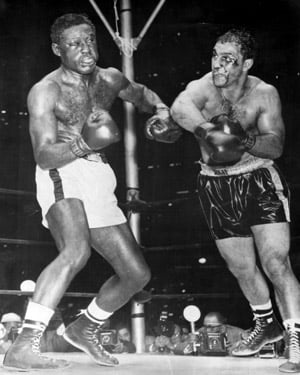 1950s
1950s
1. Rocky Marciano
2. Floyd Patterson
3. Archie Moore
4. Eddie Machen
5. Zora Folley
6. Jersey Joe Walcott
7. Tommy Jackson
8. Ezzard Charles
9. Clarence Henry
10. Bob Baker
Non-American titleholder: Ingemar Johansson (Sweden)
Light heavyweights could still effectively mix it up with the big boys in the 1950s. Even the dominant champion of the decade, undefeated legend Rocky Marciano, never weighed more than 193 pounds. Like his predecessor, Marciano did a lot to dismantle stereotypes of Italian-Americans. He reportedly cried in Joe Louis’ dressing room after stopping his hero in their famous fight.
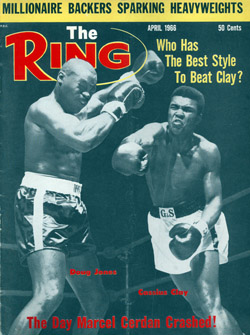 1960s
1960s
1. Muhammad Ali
2. Sonny Liston
3. Joe Frazier
4. Ernie Terrell
5. Floyd Patterson
6. Zora Folley
7. Eddie Machen
8. Jimmy Ellis
9. Jerry Quarry
10. Mac Foster
Non-American titleholders: Ingemar Johansson (Sweden)
The 1960s were a decade of change. And a new type of champion emerged to challenge old thinking in both social and sporting terms, with a mix of bravado and charisma. The self-confident and talkative Muhammad Ali (who had changed his name from Cassius Clay) became one of the first sportsmen to market himself instead of allowing an image to be created for him. Many have tried to imitate Ali; none have succeeded. Ali fought everyone in the Top 10 except Eddie Machen.
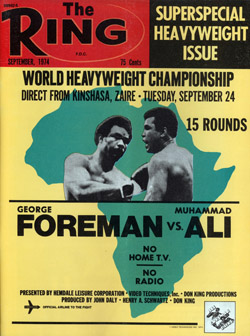 1970s
1970s
1. Muhammad Ali
2. George Foreman
3. Joe Frazier
4. Larry Holmes
5. Ken Norton
6. Jimmy Young
7. Ron Lyle
8. John Tate
9. Earnie Shavers
10. Jerry Quarry
Non-American titleholders: None
This was the golden era of heavyweights, filled with diverse skill sets and a series of unforgettable wars between great or near-great fighters. Ali vs. Frazier, Frazier vs. Foreman, Ali vs. Foreman, Ali vs. Norton  the list goes on and on. Ali became the most famous man on the planet in part because he was the best of the period but also because of his convictions and commanding personality. Ali fought everyone in the Top 10 except John Tate.
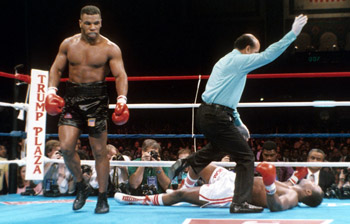 1980s
1980s
1. Mike Tyson
2. Larry Holmes
3. Pinklon Thomas
4. Evander Holyfield
5. Tim Witherspoon
6. Mike Weaver
7. Michael Spinks
8. Tony Tucker
9. Tony Tubbs
10. James “Bonecrusher” Smith
Non-American titleholders: Gerrie Coetzee (South Africa), Trevor Berbick (Canada) and Francesco Damiani (Italy)
The decade belonged to two remarkable Hall of Famers, Larry Holmes and then Mike Tyson. Holmes, the underappreciated heir to Muhammad Ali, completed his historic run of 20 successful titles defenses (second only to Joe Louis’ 25) before finally losing to Michael Spinks. Tyson became the last heavyweight who even non-sports fans would know because of a string of particularly violent knockouts and bizarre – and ultimately criminal – behavior later on.
The past two and a half decades
Since Tyson, Holyfield and Bowe faded from prominence, and even before that to some extent, the notion of widespread American control of the heavyweight division has become outdated. If you put the Big Three in a separate category, there have been six U.S. heavyweights to hold at least a share of the heavyweight title over the past 20 years. They are, in addition to Briggs:
-
Oliver McCall, who pulled off a huge upset when he stopped Lennox Lewis for the vacant WBC championship on Sept. 24, 1994, in London. After one successful defense, against an aging Larry Holmes, the “Atomic Bull” was dethroned by England’s Frank Bruno. In a rematch with Lewis, again for the vacant WBC crown, he was stopped in five rounds on Feb. 7, 1997.
-
Hasim Rahman, in much the same manner that fellow underdog McCall had, connected with a crushing right hand to the jaw to take Lewis’ WBC strap on a fifth-round knockout on April 22, 2001, in Carnival City, South Africa. In the rematch on Nov. 17 of that year, Lewis took the championship back on a fourth-round KO.
-
Undersized but gutty Chris Byrd caught a break when, trailing badly on the scorecards through nine rounds, WBO heavyweight champ Vitali Klitschko didn’t come out for the 10th round because of a shoulder injury on April 1, 2000, in Berlin. Byrd lost in his first defense, to Wladimir Klitschko, but later went on to capture the IBF belt on a unanimous decision over Evander Holyfield, and to successfully defend it four times before again losing to Wlad, on a seventh-round stoppage, on April 22, 2006.
-
Roy Jones Jr., the undisputed light heavyweight champion, bulked up and gave the much larger and decidedly slower WBA heavyweight titlist John Ruiz a boxing lesson on March 1, 2003, in Las Vegas. Jones soon after relinquished that title to move back down to light heavyweight and never again fought as a heavyweight.
-
Longshot Lamon Brewster took home the vacant WBO championship when he stopped Wladimir Klitschko in five rounds on April 10, 2004, in Las Vegas. After successful defenses against Kali Meehan, Andrew Golota and Luan Krasniqi, he was outpointed by Liakhovich on April 1, 2006, in Cleveland.
-
Ruiz became the first American Latino to win a major heavyweight title when he outpointed Holyfield to win the WBA belt in 2001. He lost it to Jones but regained it after he outpointed Rahman for the interim title and then Jones vacated the full version in 2004.
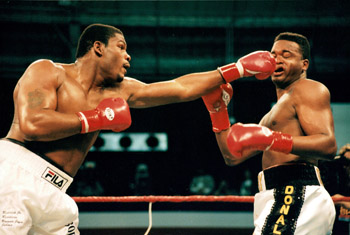 1990s
1990s
1. Riddick Bowe
2. Evander Holyfield
3. Mike Tyson
4. George Foreman
5. Michael Moorer
6. Oliver McCall
7. Buster Douglas
8. Larry Holmes
9. Ray Mercer
10. Tommy Morrison
Non-American titleholders: Francesco Damiani (Italy), Lennox Lewis (U.K.), Herbie Hide (U.K.), Frank Bruno (U.K.), Henry Akinwande (U.K.) and Vitali Klitschko (Ukraine)
Many people see this as the last quality heavyweight era worldwide. The 1990s heralded the arrival of “super heavyweights,” whose size alone won fights. American Oliver McCall managed to KO Lennox Lewis but the Briton exacted revenge and dominated the decade. Mike Tyson lost the championship to Buster Douglas in 1990 but regained two titles late in the decade before biting off a portion of Evander Holyfield’s ear. The breakup of the Soviet Union allowed a pipeline of European talent into the heavyweight division, a seismic shift in power that prevails to this day.
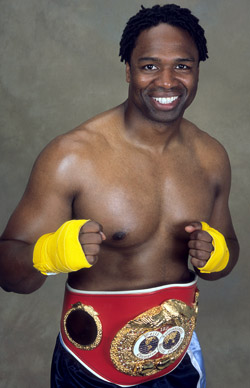 2000s
2000s
1. Chris Byrd
2. James Toney
3. Hasim Rahman
4. Evander Holyfield
5. John Ruiz
6. Lamon Brewster
7. Jameel McCline
8. Shannon Briggs
9. Eddie Chambers
10. Tony Thompson
Non-American titleholder: Lewis (U.K.), Wladimir Klitschko (Ukraine), Corrie Sanders (South Africa), Vitali Klitschko (Ukraine), Nikolai Valuev (Russia), Sergei Liakovich (Belarus), Oleg Maskaev (Russia), Ruslan Chagaev (Uzbekistan), Sultan Ibragimov (Russia), Samuel Peter (Nigeria) and David Haye (U.K.)
This was the worst full decade of American heavyweight boxing, marked by marginal talent and poor performances. The exception was Chris Byrd, an undersized defensive specialist who scored several upset victories. John Ruiz had two title reigns but never received much respect. The fact Evander Holyfield is No. 4 here even though he was near the end of his effectiveness is an indication of how weak this decade was.
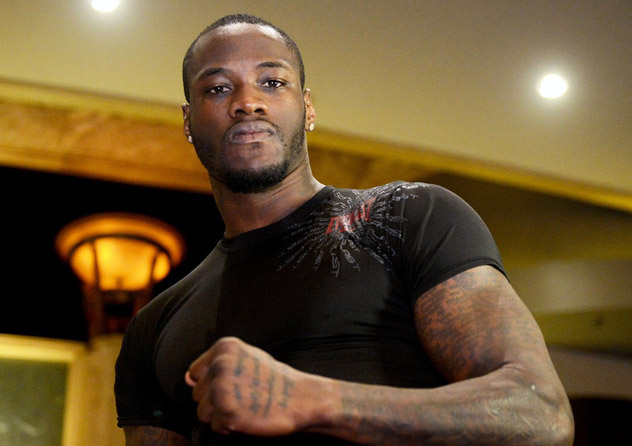 2010s
2010s
1. Deontay Wilder
2. Bryant Jennings
3. Chris Arreola
4. Tony Thompson
5. Steve Cunningham
6. Jonathan Banks
7. Seth Mitchell
8. Dominic Breazeale
9. Amir Mansour
10. Gerald Washington
Non-American titleholders: Davie Haye (U.K.), Wladimir Klitscko (Ukraine), Vitali Klitschko (Ukraine) and Bermane Stiverne (Canada)
This decade is still about the future. American hopefuls Wilder and Jennings display the type of power and intuition that could mask their lack of amateur seasoning when compared to their European counterparts. They are still trading on potential, but we’ll know soon whether they will spearhead a new era of American heavyweights or become part of the disturbing trend.
Note: The introduction for “The past two and a half decades” was written by Bernard Fernandez.
Don’t know where to find a newsstand near you that sells THE RING? Click here. To subscribe ÔÇö both to the print and digital versions ÔÇö click here. You can also purchase the current issue on that page.















